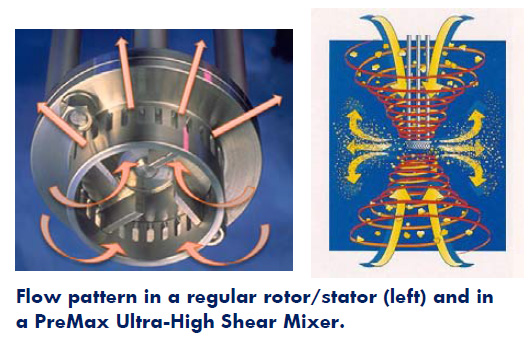Tech Report
Speed up your dispersion and milling operations.

Technology Brief
This bulletin describes a technique for obtaining better quality pre-mixes and reducing milling time in the production of ultra fine dispersions.
Multi-stage preparation of fine dispersions
Many fine solids dispersions undergo at least two distinct stages: (1) powder wet out in a batching tank and (2) inline milling to achieve the desired particle size or fineness of grind. The milling step, typically the most costly and time-consuming part of the process, does not always offer much opportunity for optimization which is why some manufacturers resort to adding more milling equipment to handle multiple passes. But over the years, focus has shifted to the wet-out stage as study after study found that the quality of the rough "pre-mix" impacts the required extent and duration of milling.
Cut cycle time from hours to minutes
Preparation of the pre-mix is commonly carried out using propellers, turbine agitators or saw-tooth dispersers mounted in open vessels. The capabilities of these mixers are generally limited to the simple wetting out of powders still in the form of agglomerates. If a pre-mixer is able to disperse these agglomerates as close as possible to the desired specifications - in other words, mimic the early stages of milling - it can reduce the number of passes through the mill and even allow the use of smaller grinding media for milling finer solids. This presents an opportunity for a tremendous increase in efficiency and reduction in cycle time.
Powder wet-out and dispersion under ultra-high shear
New rotor/stator technologies such as the Ross PreMax Ultra-High Shear Mixer with "Delta" rotor/stator (US Patent No. 6,000,840) enable manufacturers to combine solids into liquid while also accomplishing some level of grinding and deagglomeration right in the same mixing vessel.

Unlike conventional rotor/stators which draw material from the bottom of the mixing head, the Delta generator of the PreMax runs at higher tip speeds and produces a double vortex, drawing product components from above and below the rotor and expelling them radially through the openings in the stator. Powders are wetted out faster instead of floating on the liquid surface. Due to the ultra high shear conditions and more turbulent flow patterns generated by the PreMax, it is able to handle more viscous products (up to 50,000 cP) while generating higher levels of dispersion than any other batch-style mixer including high speed saw-tooth dispersers, traditional rotor/stators and immersion mills.
Mixing in a PreMax produces results comparable to one or two passes through a media mill. This reduces the number of mill passes required to achieve the target particle size distribution, and in some applications, eliminates milling entirely.
Sample Application: Phthalo Blue Dispersion

A producer of paste colors was previously pre-mixing phthalo blue pigment into an aqueous solvent using a saw-tooth disperser. The resulting pre-mix required three passes through a media mill.
Realizing they needed to speed up production and increase efficiency, the company tested several options and chose the PreMax Ultra-High Shear. It eliminated the disperser and produced a better quality pre-mix which then required only one media mill pass.